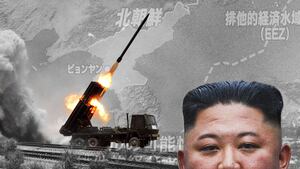SEOUL—The U.S., South Korea, and North Korea have all test-fired missiles in a dangerous duel that marks an abrupt escalation in tensions on the Korean peninsula.
The North opened the clash on Sunday, challenging both the U.S. and South Korea’s new hardline president by firing eight short-range missiles into the sea off the east coast—the most ever fired on a single day. South Korea and the U.S. responded in kind, firing eight missiles of their own into the same sea about 90 miles south on Monday.
Washington, D.C., and Seoul are expecting North Korea’s Kim Jong Un to order the North’s seventh nuclear test in the coming days. It would be its first in nearly five years.
Daniel Pinkston, who teaches international relations at the South Korean campus of Troy University, said the missile test riposte from the U.S. and South Korea means “the days of phony reality TV diplomacy of the last five years are over.” That was a reference to Donald Trump’s summit with Kim four years ago in Singapore, where he famously claimed they “fell in love,” and to the three summits between Kim and Moon Jae-in, the liberal Korean president who preceded the conservative Yoon Suk-yeol, inaugurated last month vowing no more appeasing the North.
The South Korea-U.S. exercise “demonstrated some of the alliance’s strike capability and resolve,” Pinkston told The Daily Beast, “We’ll see a more ‘normal’ joint combined, and multinational military exercise tempo in the South and around the peninsula.” And “if deterrence fails,” he added, “the ROK and U.S. militaries will be better prepared to respond to NK aggression.”
The latest conflagration began when Kim ordered a missile barrage in a fiery challenge to South Korea’s President Yoon right after U.S. and South Korean warships finished joint exercises near Okinawa, the southern Japanese island where the U.S. has its largest air base in the Pacific plus a division of marines. The aircraft carrier USS Ronald Reagan—bristling with warplanes on its flight deck—joined in the first such exercise since it cruised through waters off South Korea in 2017 after North Korea conducted its sixth and most recent nuclear test.
The North Korean challenge also answered a warning from the U.S. negotiator Sung Kim, a veteran of failed negotiations with the North, who said the U.S. was “preparing for all contingencies… to strengthen both defense and deterrence and to protect our allies.” Those forbidding words reassured South Korean and Japanese envoys meeting here that the U.S. was ready to send warplanes on warning flights near North Korea and conduct joint military exercises with the ROK—Republic of Korea—that Trump canceled after his summit in Singapore with Kim.
“The North Korean leadership is paranoid about ROK-U.S. Alliance capabilities,” said Robert Collins, who made a long career analyzing North Korea for the U.S. Forces Korea command while in the army and then as a civilian. Collins, the author of books and studies on North Korea, said the North’s “predilection for provocation and warning shots, coupled with their propaganda/information warfare, is the Kim regime's strategy to keep the alliance at bay and take advantage of any miscalculation in intelligence assessments.”
North Korea fired its missiles from four places, including at or near the airport serving Pyongyang, marking the 18th time this year that Kim has sent missiles on test flights in waters between the Korean peninsula and Japan. The North on May 26 test-fired an intercontinental ballistic missile capable of reaching targets in the U.S. as President Biden was returning to D.C. from Tokyo after his summits with Japan’s Prime Minister Fumio Kishida and in Korea with President Yoon, with whom he agreed on resuming joint military exercises. The U.S. and South Korea responded by firing two missiles off the South’s northeast coast in what the U.S. command called a “live-fire exercise.”
This time the fusillade was highlighted by a missile that South Korea’s command said owed its inspiration to the Iskander missile the Russians have deployed within about 30 miles of the border with Ukraine. The North Korean version, the KN-23, is “known for its ‘pull-up maneuver,’ designed to avoid interception,” according to Yonhap, the South Korean news agency.
“These launches would seem to be a North Korean message to the new South Korean president to cool down his participation in exercises with the U.S. and to not get cozy with Japan,” said Steve Tharp, a former army officer with the U.S. command here. “With President Yoon's administration following up with rhetoric and actions that are clearly pro-U.S. and anti-North Korea in nature, the North has to start all over again when it comes to bringing the South in line.”
North Korea is likely “to increase military provocations and attempt to ratchet up tensions with both the U.S. and the South in the coming months as part of their standard negotiation cycle,” said Tharp. “Step 1 is to cause the ‘appearance’ of tension. To effectively create this tension, North Korea upped the ante by firing eight missiles in what is their busiest launch day ever.”
The South Korean response, however, may have been stronger and faster than Kim Jong Un anticipated while fighting COVID-19 raging among a populace that’s 40 percent underfed with little or no access to medical facilities and totally unvaccinated.
“This was a proportionate response (tit for tat) to emphasize the strength and deterrence power of the ROK-U.S. Alliance,” Tharp told the Daily Beast. “It would be my guess that the Korean side advocated for this given the statements by President Yoon emphasizing that he would react strongly to North Korean provocations.”
South Korea’s joint chiefs of staff said the missiles fired by the ROK army’s tactical missile systems were all ground-to-ground. South Korean and U.S. forces joined in the exercise though only one of the eight missiles was American. The purpose, said the Korean communique, was to show the ability to strike “the origins of provocations and their command and support forces”–notably North Korean targets close to the North-South line where half the North’s 1.2 million troops are based.
Tom Coyner, who’s been tracking North Korea from here for years, linked the tests to North Korea’s efforts at developing devices capable of carrying small nuclear warheads. “We may find collaboration in the future of matching multiple, small nuclear tests with these smaller rocket tests,” he forecast.
That danger “should force the South Korean and American governments to quicken plans to provide some kinds of 'iron dome' protections for Seoul and other population centers as well as U.S. forces and assets,” Coyner said. The Biden administration should “remind Pyongyang that the U.S. is still good with its threat to obliterate the North” if Kim were to “restart the Korean War.”
President Yoon agreed. “North Korea's nuclear and missile (programs) are reaching the level of threatening not only peace on the Korean Peninsula but also in Northeast Asia and the world,” Yonhap quoted him as saying. “We will make sure there isn’t a single crack in protecting the lives and property of our people.”







